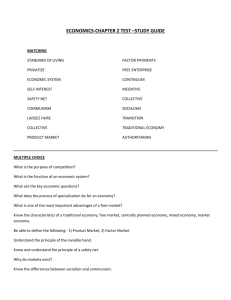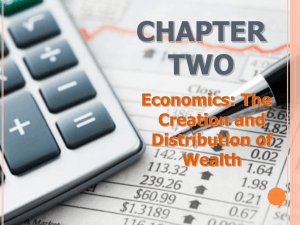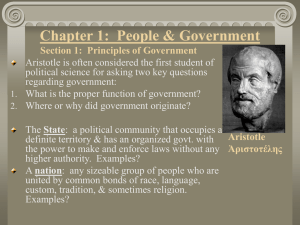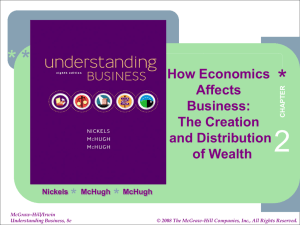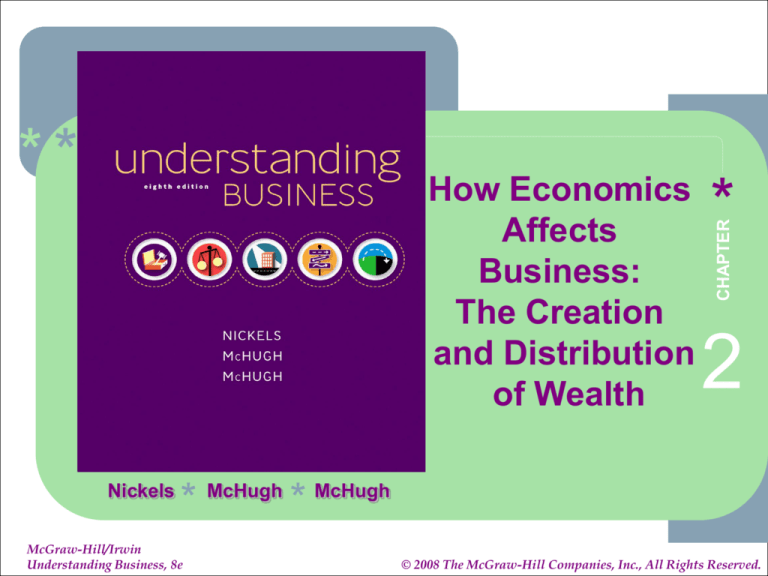
*
*
*
How Economics
Affects
Business:
The Creation
and Distribution
of Wealth
Nickels
*
McGraw-Hill/Irwin
Understanding Business, 8e
McHugh
*
*
CHAPTER
**
2
McHugh
1-1
2-1
© 2008 The McGraw-Hill Companies, Inc., All Rights Reserved.
*
*
*
Learning goals
• Compare and contrast the economics of despair with
the economics of growth.
• Explain what capitalism is and how free markets work.
• Discuss the major differences between socialism and
communism.
• Explain the trend toward mixed economies.
• Discuss the economic system of the united states,
including the significance of key economic indicators
(GDP), productivity, and the business cycle.
• Define fiscal policy and monetary policy, and explain
how each affect the economy.
2-2
*
*
*
Economics: Create Wealth
• Study of how society chooses to
employ resources to produce
goods & services and distribute
them among competing
groups/individuals
• Micro v. Macro
• Resource Development
2-3
*
*
*
Four “What’s” of
an Economic System
$ What is produced?
$ What amount is produced?
$ What is the method of output
distribution?
$ What is the rate of economic growth?
Adapted from: Edwin Mansfield Economics (New York: W.W. Norton, 1976), p.8
2-4
*
*
*
Economic Theories
•
Thomas Malthus (Early 1800s)
• “Dismal Science”
• Too many people
•
Adam Smith (1776)
• Freedom is vital
• “Invisible Hand”
2-5
*
*
*
Circular Flow Model
2-6
*
*
*
Three Economic Systems
Mixed
Socialism
(Highly Controlled)
(Little Control)
Communism
Capitalism
2-7
*
*
*
Free-Market Capitalism
•
Private Property
•
Business Ownership/
Profits
•
Freedom of Competition
•
Freedom of Choice
2-8
*
*
*
Supply Curve
High
Price(P)
S
Low
Quantity(S)
High
2-9
*
*
*
Demand Curve
High
Price(P)
D
Low
Quantity(D)
High
2-10
*
*
*
Equilibrium Point
Surplus
High
Market Equilibrium
Price
S
Low
Shortage
Quantity
D
High
2-11
*
*
*
Free-Market Competition
Monopolistic
Oligopoly
Competition
One
Many
Perfect
Competition
Monopoly
Sellers
2-12
*
*
*
Perfect Competition
Sellers
Buyer
2-13
*
*
*
Monopolistic Competition:
Many Sellers With Perceived Differences
•
Fast Food
•
Colleges
2-14
*
*
*
Oligopoly: Few Sellers
•
Automobiles
•
Tobacco
2-15
*
*
*
Monopoly: One Seller
•
Utilities
• Microsoft?
2-16
*
*
*
Limits of Free-Markets
•
Inequality of Wealth- Causes
National & World Tension
•
Greed Compromises Ethics
•
Limitations Push Country
towards Socialism =
Government Regulation
2-17
*
*
*
Industrialized Nations’
Top Individual Tax Rate
U.S.
Japan
Germany
Italy
Spain
France
Austria
Denmark
0%
10%
20%
30%
40%
50%
60%
70%
Source: www.worldwide-tax.com, May 9, 2006
2-18
*
*
*
Socialism
•
Private & Public Ownership
•
Some Choices are Limited
• Creates Social Equality
• Reduces Individual Incentive
- Brain Drain
2-19
*
*
*
Communism
•
Public Ownership
•
•
Almost all major factors of
production
Central Planning/Controlled
Economy
• Shortages of food and other products
may develop
• Lack of motivation to work hard for
business people
2-20
*
*
*
Mixed Economies
•
Free-Market Economy = Capitalism
•
Command Economy
• Socialism
• Communism
•
Trend Results in Blend/Mix
• Capitalism > Socialism
• Socialism > Capitalism
2-21
*
*
*
Why is the U.S.
an Economic Success?
Major Reason
Percent*
Constitution
85
Free Elections
84
Free Enterprise System
81
Abundant Resources
78
Cultural Diversity
71
* Respondents could choose more than one.
Source: Investors Business Daily Survey
2-22
*
*
*
U.S. Economy
•
•
•
•
Key Economic Indicators
Productivity in the U.S.
Productivity in the Service Sector
Business Cycles
• Recession
• Depression
• Recovery
• Stabilization
• Fiscal Policy
• National Debt
• Economic Growth through Monetary Policy
2-23
*
*
*
Key Economic Indicators
•
Gross Domestic Product (GDP)
•
Unemployment Rate
•
Price Indexes
• Consumer Price Index (CPI)
• Producer Price Index (PPI)
2-24
*
*
*
U.S. Gross
Domestic Product
14,000
12,000
10,000
8,000
In Billions of U.S. $
6,000
4,000
2,000
0
1940
1950
Source: U.S. Dept. of Commerce, Bureau of Economic Analysis
1960
1970
1980
1990
2000
2002
2005
2-25
*
*
*
Share of World GDP(%)
1975
•G-8 Countries
•U.S. only
•China
•India
•Latin America
•Africa
55
22
5
3
7
3
2004
44
21
13
6
6
3
Source: www.dlc.org/ppi, July 6, 2005
2-26
*
*
*
U.S. Unemployment (%)
16
14
12
10
8
6
4
2
0
1940
1950
1960
1970
1980
1990
2000
2002
2005
Source: U.S. Bureau of Labor Statistics
Source: U.S. Bureau of Labor Statistics
2-27
*
*
*
What Makes Up The
Consumer Price Index?
Recreation Apparel
5%
6%
Medical Care/
Insurance
7%
Medical Care
6%
Other
5%
Housing & Util.
39%
Food &
Beverage
16%
Transportation
18%
Source: U.S. Bureau of Labor Statistics
2-28
*
*
*
Consumer Price Index
250
200
150
100
50
1982-84 = 100
0
1940
1950
1960
1970
1980
1990
2000
2002
Apr.
2006
Source: U.S. Dept. of Labor, Bureau of Labor Statistics
2-29
*
*
*
Percent Change in Labor
Productivity- U.S.
9
8
7
6
5
4
3
2
1
0
-1
1950
1960
1970
Source: U.S. Dept. of Commerce, Bureau of Labor Statistics
1980
1990
2000
2002
Q1 2006
2-30
*
*
*
Where Does the
Government Get Its Money?
4%
4%
9%
43%
Individual Income
Taxes
Social Security &
Payroll Taxes
Corporate Taxes
Excise Taxes
40%
Other
Source: Office of Management & Budget, 2002
2-31
*
*
*
Federal Spending
50%
45%
40%
35%
30%
25%
20%
15%
10%
5%
0%
1966
2006
Medicare &
Medicaid
Social
Security
Interest
Defense
Other
Source: Congressional Budget Office
2-32
*
*
*
Biggest Economic
Challenges
• Over the Next 3-5 years the U.S. can be
expected to face these challenges:
•
•
•
•
•
Pension & Health care costs
The Federal Deficit
High Energy and Commodity Costs
Balance of payments
Terrorism
Source: Investors Business Daily January 9, 2006
2-33
*
*
*
Healthcare Expenditure
Projections
(Percent of National GDP)
18.00%
17.50%
17.00%
16.50%
16.00%
15.50%
15.00%
14.50%
14.00%
2004
2006
2008
2010
2012
% of GDP
Source: FORTUNE May 3, 2004
2-34
*
*
*
Rising U.S. Trade Deficit
0
-100000
-200000
-300000
Deficit in
Millions
-400000
-500000
-600000
-700000
-800000
1980 1985 1990 1995 1999 2001 2003 2005
Source: US Dept of Commerce, Bureau of Economic Analysis
2-35
*
*
*
Where are the Homeland
Security Dollars Spent?
14
12
10
8
6
4
2
0
Border & Port
Security
Aviation Security
Immigration
Enforcement
BioDefense
Infrastructure
Protection
Source: Business Week June 14, 2004
2-36
*
*
*
What is the National Debt?
• The debt has reached $8.36
trillion+ (May 2006)
• If $1,000 bills were stacked:
• $1 Million = 4.29 Inches
• $1 Billion = 357.5 Feet
• $1 Trillion =
67 Miles
• The debt is equal to 560.1 miles in
$1,000 bills
• National Debt Clockhttp://www.brillig.com/debt_clock/
2-37




